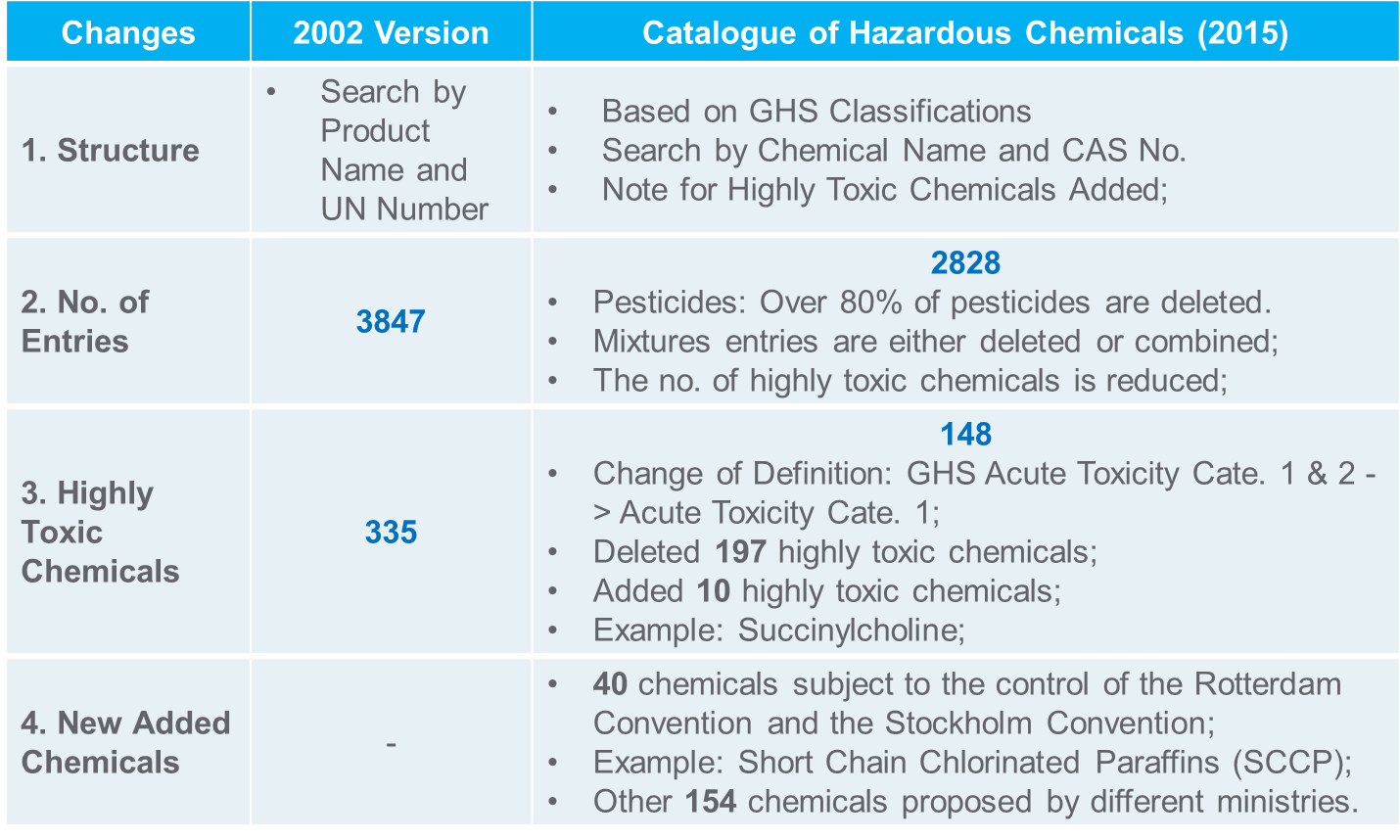China Catalogue of Hazardous Chemicals 2015
Little Pro on 2015-12-30
China State Administration of Work Safety (SAWS) issued its revised Catalogue of Hazardous Chemicals (2015) in March. The new Catalogue includes 2,828 entries covering more than 2,800 hazardous substances and some mixtures. The Catalogue came into force on 1 May 2015. In Sept 2015, SAWS issued a guidance document containing official GHS classifications for chemicals in the Catalogue.
To download the Chinese version of the Catalogue of Hazardous Chemicals (2015) with mandatory GHS classifications, please click the first blue link on the following page. You can search the Catalogue by CAS number.
- Catalogue of Hazardous Chemicals (2015) - English;
Changes in New Catalogue of Hazardous Chemicals
Compared to the Catalogue of Hazardous Chemicals (2002), there are 4 big changes in the New Catalogue: structure, No. of entries, No. of highly toxic chemicals and newly added chemicals. The picture below summarizes all 4 big changes:

5 Facts about the New Catalogue of Hazardous Chemicals (2015)
To help you understand the potential impacts of this Catalogue on your business, we have summarized top 5 facts that you need to be aware of.
Fact 1: It is an administrative license Catalogue, not a complete list of hazardous chemicals in China.
Chemicals in the Catalogue are selected from hazardous chemicals with more severe hazards. The Catalogue of Hazardous Chemicals itself is an administrative license Catalogue. For chemicals listed in the Catalogue, businesses that produce, import, distribute or use them in China will be subject to license requirements (production license, operation license, safe use license, etc.) under State Council Decree 591 Regulations on Safe Management of Hazardous Chemicals.
For example, chemicals classified with acute toxicity category 4 do not meet criteria for inclusion in the Catalogue. However, they are still hazardous and subject to mandatory SDSs and labelling requirements under Decree 591.
Fact 2: The Catalogue includes mostly substances. Only a few mixtures are included.
There are 2,828 entries in the new Catalogue. Over 95% of entries are pure substances with concrete CAS numbers. Yet, it does include a few mixtures and one generic entry. Attention shall be drawn to the generic entry 2828 which covers all preparations with flash points below than 60 celsius degrees (close-cup).
It shall be noted that a substance refers to an industrial product as it is produced. There is no minimum concentration set for a product to meet the definition of a substance.
Fact 3: The Catalogue is also a compulsory GHS classification list in China
For chemicals listed in the Catalogue, industry must use the published classifications or more severe ones to classify their chemicals and prepare safety data sheets.
Fact 4: HazChem registration is not limited to those hazardous chemicals listed in the Catalogue.
Under SAWS’s order 53, manufacturers and importers of hazardous chemicals shall register such chemicals with the National Registration Centre for Chemicals (NRCC) of SAWS prior to production and importation. It is never SAWS’s intention that such registration requirement is limited to only listed substances and a small number of mixtures.
Fact 5: Not every hazardous chemical in the Catalogue is treated the same.
Hazardous chemicals which are indicated as “Highly Toxic” in the Catalogue and explosives precursors are subject to additional license and reporting requirements on storage, sales and purchase under the State Council Decree 591. The Catalogue also includes some chemical weapons precursors and drug precursor chemicals which are subject to additional control by other regulations.
Having Questions?
We do not provide consultancy services. If you have questions or need any help, please contact our sponsor. You may also find an expert in CSP business directory below. If you are a consultant, you may get yourself listed in CSP business directory (free) or sponsor this page to leave your contact info on this page..
